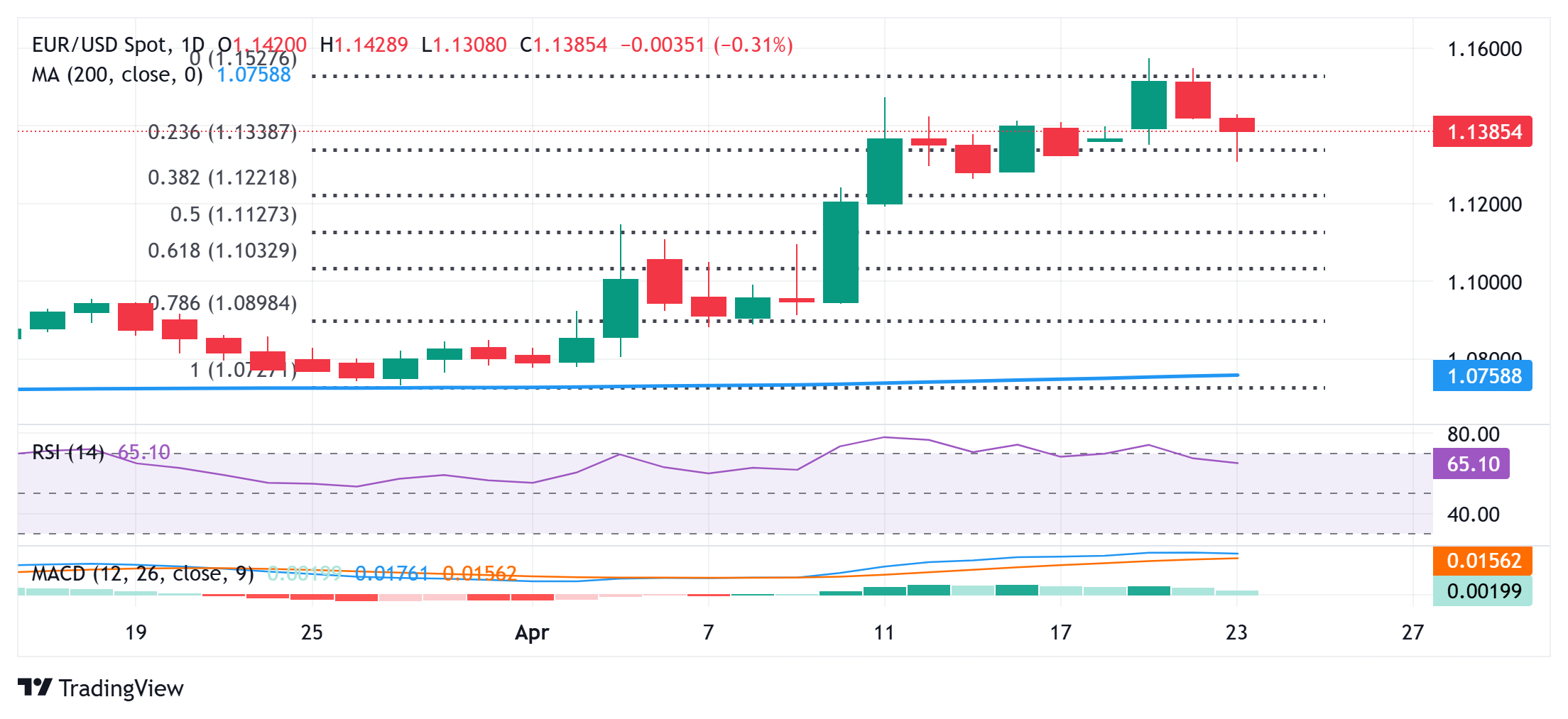EUR/USD Price Forecast: Bounces off 1.1300 neighborhood; shows resilience below 23.6% Fibo.
- EUR/USD drifts lower for the second straight day amid a further USD recovery from a multi-year low
- The technical setup favors bulls and warrants caution before positioning for a deeper corrective fall.
- A sustained break and acceptance below 1.1300 could pave the way for some meaningful decline.
The EUR/USD pair attracts some follow-through selling for the second straight day on Wednesday and drops to a one-week low during the Asian session. Spot prices, however, rebound a few pips from the 1.1300 neighborhood and currently trade around the 1.1380 region, still down over 0.35% for the day.
The US Dollar (USD) builds on the overnight bounce from the vicinity of a three-year low touched on Monday and turns out to be a key factor exerting downward pressure on the EUR/USD pair. That said, the weakening confidence in the US economy, along with the prospects for more aggressive policy easing by the Federal Reserve (Fed) and the risk-on impulse, caps gains for the safe-haven buck and helps limit losses for the currency pair.
From a technical perspective, the EUR/USD pair showed resilience below the 23.6% Fibonacci retracement level of the recent rally witnessed over the past month or so, from the very important 200-day Simple Moving Average (SMA). Furthermore, the bullish Moving Average Convergence Divergence (MACD), along with the fact that the daily Relative Strength Index (RSI) on the daily chart has eased from the overbought zone, favors bulls.
Hence, it will be prudent to wait for a sustained break and acceptance below the 1.1300 round figure before confirming that the EUR/USD pair has topped out near the 1.1575 area, or the highest level since November 2021 touched earlier this month. This will set the stage for a further corrective decline towards the 1.1250 area, or the 38.2% Fibo. level, en route to the 1.1200 mark and the 1.1160-1.1155 region, representing the 50% Fibo. level.
On the flip side, the 1.1400 round figure might now act as an immediate hurdle ahead of the Asian session high, around the 1.1425-1.1430 region. Some follow-through buying should lift the EUR/USD pair further beyond the 1.1500 psychological mark, towards challenging the multi-year peak, around the 1.1575 region touched earlier this month. Spot prices could eventually aim to reclaim the 1.1600 round-figure mark.
EUR/USD daily chart

Euro FAQs
The Euro is the currency for the 19 European Union countries that belong to the Eurozone. It is the second most heavily traded currency in the world behind the US Dollar. In 2022, it accounted for 31% of all foreign exchange transactions, with an average daily turnover of over $2.2 trillion a day. EUR/USD is the most heavily traded currency pair in the world, accounting for an estimated 30% off all transactions, followed by EUR/JPY (4%), EUR/GBP (3%) and EUR/AUD (2%).
The European Central Bank (ECB) in Frankfurt, Germany, is the reserve bank for the Eurozone. The ECB sets interest rates and manages monetary policy. The ECB’s primary mandate is to maintain price stability, which means either controlling inflation or stimulating growth. Its primary tool is the raising or lowering of interest rates. Relatively high interest rates – or the expectation of higher rates – will usually benefit the Euro and vice versa. The ECB Governing Council makes monetary policy decisions at meetings held eight times a year. Decisions are made by heads of the Eurozone national banks and six permanent members, including the President of the ECB, Christine Lagarde.
Eurozone inflation data, measured by the Harmonized Index of Consumer Prices (HICP), is an important econometric for the Euro. If inflation rises more than expected, especially if above the ECB’s 2% target, it obliges the ECB to raise interest rates to bring it back under control. Relatively high interest rates compared to its counterparts will usually benefit the Euro, as it makes the region more attractive as a place for global investors to park their money.
Data releases gauge the health of the economy and can impact on the Euro. Indicators such as GDP, Manufacturing and Services PMIs, employment, and consumer sentiment surveys can all influence the direction of the single currency. A strong economy is good for the Euro. Not only does it attract more foreign investment but it may encourage the ECB to put up interest rates, which will directly strengthen the Euro. Otherwise, if economic data is weak, the Euro is likely to fall. Economic data for the four largest economies in the euro area (Germany, France, Italy and Spain) are especially significant, as they account for 75% of the Eurozone’s economy.
Another significant data release for the Euro is the Trade Balance. This indicator measures the difference between what a country earns from its exports and what it spends on imports over a given period. If a country produces highly sought after exports then its currency will gain in value purely from the extra demand created from foreign buyers seeking to purchase these goods. Therefore, a positive net Trade Balance strengthens a currency and vice versa for a negative balance.


